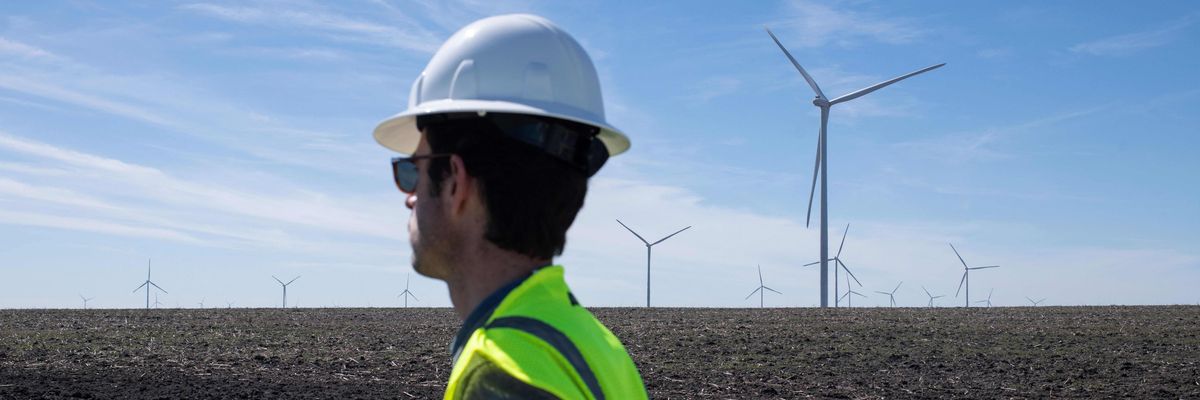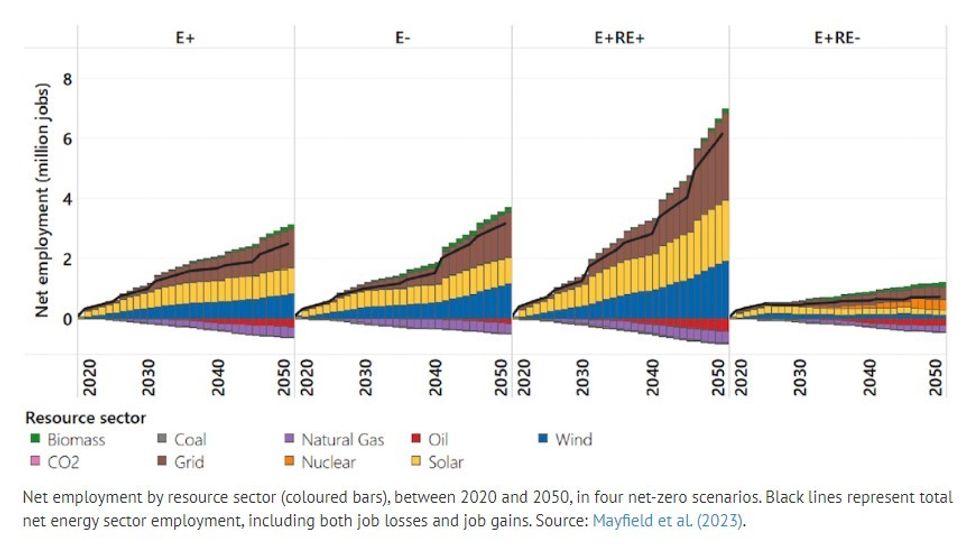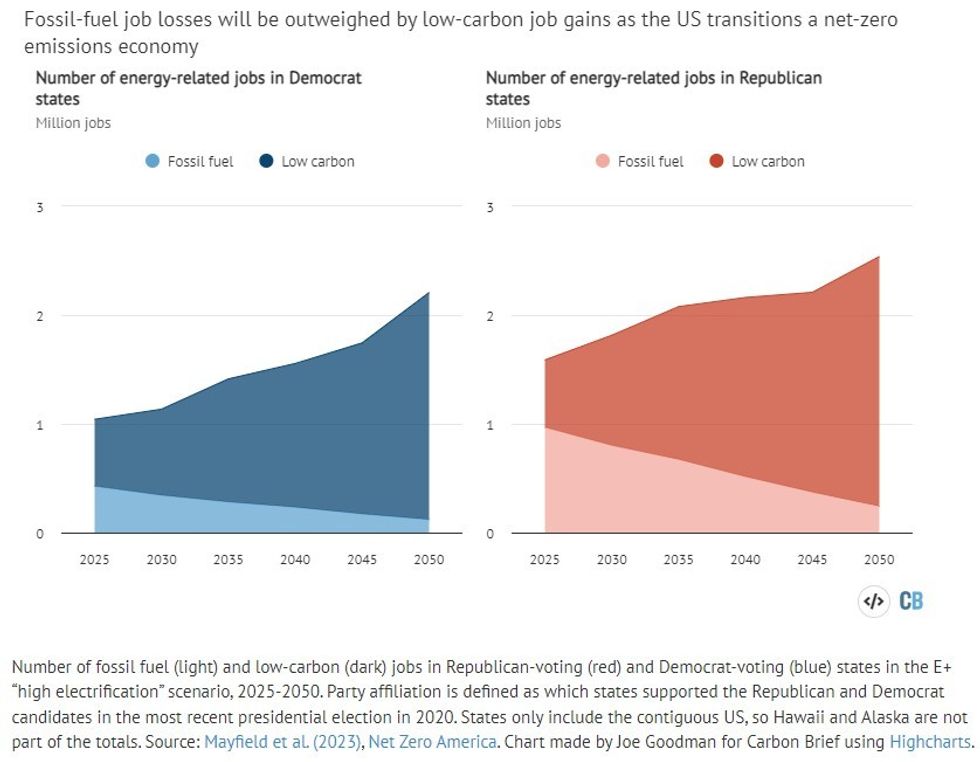
An Engie worker is seen during the dedication of the Limestone Wind Project in Dawson, Texas on February 28, 2023.
Green Job Creation Projected to 'Offset' Fossil Fuel Job Losses in GOP States
"Total employment in the nationwide U.S. energy sector could double or even triple by 2050 to meet the demand for wind turbines, solar panels, and transmission lines," according to a new study.
Achieving net-zero greenhouse gas emissions in the United States by mid-century would lead to a net increase in energy-related employment nationwide, and Republican-voting states whose leaders have done the most to disparage climate action would see the largest growth in green jobs.
That's according to research published in the latest issue of the peer-reviewed journal Energy Policy. The new study, summarized Tuesday by Carbon Brief, undercuts the old right-wing canard that environmentally friendly policies are inherently bad for workers.
Four academics led by Dartmouth College engineering professor Erin Mayfield found that shifting to a net-zero economy could create millions of jobs in low-carbon sectors—enough to "offset" losses in the declining fossil fuel industry, not only in the aggregate but also in most dirty energy-producing states, which tend to be GOP strongholds.
"Total employment in the nationwide U.S. energy sector could double or even triple by 2050 to meet the demand for wind turbines, solar panels, and transmission lines," Carbon Brief reported. Such growth in clean power generation and dissemination "would outweigh losses in most of the country's fossil fuel-rich regions, as oil, coal, and gas operations close down."
The study adds to mounting evidence that so-called "red" states now dominated by Republicans and fossil fuel interests—including particularly sunny and windy ones like Oklahoma, Texas, and Wyoming—stand to reap the biggest rewards from the green industrial policy provisions in the Inflation Reduction Act passed by congressional Democrats and signed into law by President Joe Biden last year.
At the same time, the authors acknowledge that some GOP-controlled dirty energy-producing states, such as North Dakota, are likely to see net decreases in energy sector employment, and they stress that "many communities will still require help to ensure a 'just transition' away from fossil fuels," as Carbon Brief noted.
In their paper, Mayfield and her three co-authors—Jesse Jenkins, Eric Larson, and Chris Greig, all of whom work at Princeton University—estimate how energy-related employment in the U.S. would change depending on different emission reduction contexts.
To simulate "labor market pathways of large-scale, low-carbon energy-supply infrastructure development," the team developed the Decarbonization Employment and Energy Systems (DEERS) model, which combines myriad economic and energy data, and then applied it to four alternative scenarios from the 2021 Net-Zero America report they were all involved in writing.
The transition scenarios, which assume varying levels of electrification and renewable energy supply, are as follows:
- High electrification by 2050 and without renewable deployment constraints (E+);
- Moderate electrification by 2050 and without renewable deployment constraints (E-);
- High electrification by 2050 and with 100% of energy derived from renewable sources by 2050 (E + RE+); and
- High electrification by 2050 and with renewable deployment constrained to current capacity expansion rates (E + RE-).
The authors expect overall energy sector employment to climb in all four scenarios, although net job gains are limited under E+ RE- conditions in which the deployment of renewables is constrained.
"We find that a net-zero transition supports an annual average of approximately 3 million direct energy jobs or $200 billion in wages during the first decade, and approximately 4-8 million direct energy jobs or $200-500 billion during the 2040s," they wrote. "The modeled supply-side energy workforce represents 1.5% of the total U.S. labor force in 2020, increasing to 2.5-5% by mid-century."
As Carbon Brief reported: "The number of energy-related jobs roughly doubles in both the 'high electrification' (E+) and 'less-high electrification' (E-) scenarios, which focus on the extent to which transport and buildings are electrified by 2050. The largest growth is seen in the E + RE+ scenario, which features high electrification and a 100% renewable power system by 2050."
"Notably, the research finds that many fossil fuel jobs would have been lost even in the absence of new climate policy," the outlet noted. "It suggests there would be a drop of one-third by 2050, as coal and gas are driven out of the market by cheaper wind and solar."
According to Mayfield and her colleagues, "In most states, job losses in declining fossil fuel sectors are offset by an increasing number of energy jobs in low-carbon sectors."
Carbon Brief observed that "this is particularly evident in Republican-voting states, which have larger energy workforces. In the E+ scenario, these states would lose around 700,000 fossil fuel jobs but gain 1.7 million low-carbon energy jobs between 2025 and 2050."
The outlet created a chart to visualize the paper's projection of rising energy-related employment under the E+ scenario in "red" states that voted for former President Donald Trump in 2020 and "blue" states that backed Biden.
In their paper, Mayfield and her colleagues cite the example of Texas, a GOP stronghold that is simultaneously the nation's top fossil fuel-producing state and its top generator of electricity from wind and solar.
As Carbon Brief pointed out:
By 2025 in the E+ scenario, around 480,000 of the state's 660,000-strong energy workforce are employed in the fossil fuel sector, more than 72% of the total. Within 25 years, many of these jobs would be lost as the number of fossil fuel employees falls to 123,000.
Yet the state would still see a big uptick in energy sector employment by 2050. The modeling suggests Texas would have around 778,000 energy jobs in 2050, with around 84% employed in low-carbon industries.
Despite this, Inside Climate News reported last month that Texas Republicans recently introduced legislation "intended to punish renewable energy and boost fossil fuels, including a measure that would increase the amount of gas-fired electricity generated by the state by upwards of 10 gigawatts and one that would limit the development of renewable energy in the state based on how much natural gas generation is also being built."
For decades, Republicans have couched their opposition to climate policies in the language of protecting the jobs of fossil fuel workers. In many cases, GOP candidates perceived to be defending the interests of dirty energy-producing communities have been rewarded by voters in those localities.
While Trump's stated support for coal workers benefited him politically in 2016, employment in the sector still fell by a quarter during his reign. Biden, by contrast, has made clear that "creating jobs and tackling climate change go hand in hand."
Evidence is growing that the clean energy transition is poised to be a major job-creator rather than a job-killer as suggested by right-wing lawmakers.
It remains to be seen whether the political allegiances of fossil fuel workers—who have previously expressed interest in moving into the green sector—will change to reflect the fact that Democrats, not Republicans, are most aggressively fighting to boost energy sector employment.
Of course, there are other important factors to consider in addition to the quantity of low-carbon jobs created, as the authors of the paper acknowledge. The quality of green sector work—whether it is unionized and high-paying, for instance, or precarious and poorly remunerated—will play a large role in determining public support for the shift to renewables.
An Urgent Message From Our Co-Founder
Dear Common Dreams reader, The U.S. is on a fast track to authoritarianism like nothing I've ever seen. Meanwhile, corporate news outlets are utterly capitulating to Trump, twisting their coverage to avoid drawing his ire while lining up to stuff cash in his pockets. That's why I believe that Common Dreams is doing the best and most consequential reporting that we've ever done. Our small but mighty team is a progressive reporting powerhouse, covering the news every day that the corporate media never will. Our mission has always been simple: To inform. To inspire. And to ignite change for the common good. Now here's the key piece that I want all our readers to understand: None of this would be possible without your financial support. That's not just some fundraising cliche. It's the absolute and literal truth. We don't accept corporate advertising and never will. We don't have a paywall because we don't think people should be blocked from critical news based on their ability to pay. Everything we do is funded by the donations of readers like you. Will you donate now to help power the nonprofit, independent reporting of Common Dreams? Thank you for being a vital member of our community. Together, we can keep independent journalism alive when it’s needed most. - Craig Brown, Co-founder |
Achieving net-zero greenhouse gas emissions in the United States by mid-century would lead to a net increase in energy-related employment nationwide, and Republican-voting states whose leaders have done the most to disparage climate action would see the largest growth in green jobs.
That's according to research published in the latest issue of the peer-reviewed journal Energy Policy. The new study, summarized Tuesday by Carbon Brief, undercuts the old right-wing canard that environmentally friendly policies are inherently bad for workers.
Four academics led by Dartmouth College engineering professor Erin Mayfield found that shifting to a net-zero economy could create millions of jobs in low-carbon sectors—enough to "offset" losses in the declining fossil fuel industry, not only in the aggregate but also in most dirty energy-producing states, which tend to be GOP strongholds.
"Total employment in the nationwide U.S. energy sector could double or even triple by 2050 to meet the demand for wind turbines, solar panels, and transmission lines," Carbon Brief reported. Such growth in clean power generation and dissemination "would outweigh losses in most of the country's fossil fuel-rich regions, as oil, coal, and gas operations close down."
The study adds to mounting evidence that so-called "red" states now dominated by Republicans and fossil fuel interests—including particularly sunny and windy ones like Oklahoma, Texas, and Wyoming—stand to reap the biggest rewards from the green industrial policy provisions in the Inflation Reduction Act passed by congressional Democrats and signed into law by President Joe Biden last year.
At the same time, the authors acknowledge that some GOP-controlled dirty energy-producing states, such as North Dakota, are likely to see net decreases in energy sector employment, and they stress that "many communities will still require help to ensure a 'just transition' away from fossil fuels," as Carbon Brief noted.
In their paper, Mayfield and her three co-authors—Jesse Jenkins, Eric Larson, and Chris Greig, all of whom work at Princeton University—estimate how energy-related employment in the U.S. would change depending on different emission reduction contexts.
To simulate "labor market pathways of large-scale, low-carbon energy-supply infrastructure development," the team developed the Decarbonization Employment and Energy Systems (DEERS) model, which combines myriad economic and energy data, and then applied it to four alternative scenarios from the 2021 Net-Zero America report they were all involved in writing.
The transition scenarios, which assume varying levels of electrification and renewable energy supply, are as follows:
- High electrification by 2050 and without renewable deployment constraints (E+);
- Moderate electrification by 2050 and without renewable deployment constraints (E-);
- High electrification by 2050 and with 100% of energy derived from renewable sources by 2050 (E + RE+); and
- High electrification by 2050 and with renewable deployment constrained to current capacity expansion rates (E + RE-).
The authors expect overall energy sector employment to climb in all four scenarios, although net job gains are limited under E+ RE- conditions in which the deployment of renewables is constrained.
"We find that a net-zero transition supports an annual average of approximately 3 million direct energy jobs or $200 billion in wages during the first decade, and approximately 4-8 million direct energy jobs or $200-500 billion during the 2040s," they wrote. "The modeled supply-side energy workforce represents 1.5% of the total U.S. labor force in 2020, increasing to 2.5-5% by mid-century."
As Carbon Brief reported: "The number of energy-related jobs roughly doubles in both the 'high electrification' (E+) and 'less-high electrification' (E-) scenarios, which focus on the extent to which transport and buildings are electrified by 2050. The largest growth is seen in the E + RE+ scenario, which features high electrification and a 100% renewable power system by 2050."
"Notably, the research finds that many fossil fuel jobs would have been lost even in the absence of new climate policy," the outlet noted. "It suggests there would be a drop of one-third by 2050, as coal and gas are driven out of the market by cheaper wind and solar."
According to Mayfield and her colleagues, "In most states, job losses in declining fossil fuel sectors are offset by an increasing number of energy jobs in low-carbon sectors."
Carbon Brief observed that "this is particularly evident in Republican-voting states, which have larger energy workforces. In the E+ scenario, these states would lose around 700,000 fossil fuel jobs but gain 1.7 million low-carbon energy jobs between 2025 and 2050."
The outlet created a chart to visualize the paper's projection of rising energy-related employment under the E+ scenario in "red" states that voted for former President Donald Trump in 2020 and "blue" states that backed Biden.
In their paper, Mayfield and her colleagues cite the example of Texas, a GOP stronghold that is simultaneously the nation's top fossil fuel-producing state and its top generator of electricity from wind and solar.
As Carbon Brief pointed out:
By 2025 in the E+ scenario, around 480,000 of the state's 660,000-strong energy workforce are employed in the fossil fuel sector, more than 72% of the total. Within 25 years, many of these jobs would be lost as the number of fossil fuel employees falls to 123,000.
Yet the state would still see a big uptick in energy sector employment by 2050. The modeling suggests Texas would have around 778,000 energy jobs in 2050, with around 84% employed in low-carbon industries.
Despite this, Inside Climate News reported last month that Texas Republicans recently introduced legislation "intended to punish renewable energy and boost fossil fuels, including a measure that would increase the amount of gas-fired electricity generated by the state by upwards of 10 gigawatts and one that would limit the development of renewable energy in the state based on how much natural gas generation is also being built."
For decades, Republicans have couched their opposition to climate policies in the language of protecting the jobs of fossil fuel workers. In many cases, GOP candidates perceived to be defending the interests of dirty energy-producing communities have been rewarded by voters in those localities.
While Trump's stated support for coal workers benefited him politically in 2016, employment in the sector still fell by a quarter during his reign. Biden, by contrast, has made clear that "creating jobs and tackling climate change go hand in hand."
Evidence is growing that the clean energy transition is poised to be a major job-creator rather than a job-killer as suggested by right-wing lawmakers.
It remains to be seen whether the political allegiances of fossil fuel workers—who have previously expressed interest in moving into the green sector—will change to reflect the fact that Democrats, not Republicans, are most aggressively fighting to boost energy sector employment.
Of course, there are other important factors to consider in addition to the quantity of low-carbon jobs created, as the authors of the paper acknowledge. The quality of green sector work—whether it is unionized and high-paying, for instance, or precarious and poorly remunerated—will play a large role in determining public support for the shift to renewables.
- Opinion | Is Wyoming’s Wind Boom Really Green? | Common Dreams ›
- Opinion | What a GOP Government Will Really Mean for the Renewable Energy Rollout | Common Dreams ›
- Opinion | We Can Accelerate the Clean Energy Transition, Even Under Trump | Common Dreams ›
- Opinion | Why Republicans Should Champion Clean Energy | Common Dreams ›
Achieving net-zero greenhouse gas emissions in the United States by mid-century would lead to a net increase in energy-related employment nationwide, and Republican-voting states whose leaders have done the most to disparage climate action would see the largest growth in green jobs.
That's according to research published in the latest issue of the peer-reviewed journal Energy Policy. The new study, summarized Tuesday by Carbon Brief, undercuts the old right-wing canard that environmentally friendly policies are inherently bad for workers.
Four academics led by Dartmouth College engineering professor Erin Mayfield found that shifting to a net-zero economy could create millions of jobs in low-carbon sectors—enough to "offset" losses in the declining fossil fuel industry, not only in the aggregate but also in most dirty energy-producing states, which tend to be GOP strongholds.
"Total employment in the nationwide U.S. energy sector could double or even triple by 2050 to meet the demand for wind turbines, solar panels, and transmission lines," Carbon Brief reported. Such growth in clean power generation and dissemination "would outweigh losses in most of the country's fossil fuel-rich regions, as oil, coal, and gas operations close down."
The study adds to mounting evidence that so-called "red" states now dominated by Republicans and fossil fuel interests—including particularly sunny and windy ones like Oklahoma, Texas, and Wyoming—stand to reap the biggest rewards from the green industrial policy provisions in the Inflation Reduction Act passed by congressional Democrats and signed into law by President Joe Biden last year.
At the same time, the authors acknowledge that some GOP-controlled dirty energy-producing states, such as North Dakota, are likely to see net decreases in energy sector employment, and they stress that "many communities will still require help to ensure a 'just transition' away from fossil fuels," as Carbon Brief noted.
In their paper, Mayfield and her three co-authors—Jesse Jenkins, Eric Larson, and Chris Greig, all of whom work at Princeton University—estimate how energy-related employment in the U.S. would change depending on different emission reduction contexts.
To simulate "labor market pathways of large-scale, low-carbon energy-supply infrastructure development," the team developed the Decarbonization Employment and Energy Systems (DEERS) model, which combines myriad economic and energy data, and then applied it to four alternative scenarios from the 2021 Net-Zero America report they were all involved in writing.
The transition scenarios, which assume varying levels of electrification and renewable energy supply, are as follows:
- High electrification by 2050 and without renewable deployment constraints (E+);
- Moderate electrification by 2050 and without renewable deployment constraints (E-);
- High electrification by 2050 and with 100% of energy derived from renewable sources by 2050 (E + RE+); and
- High electrification by 2050 and with renewable deployment constrained to current capacity expansion rates (E + RE-).
The authors expect overall energy sector employment to climb in all four scenarios, although net job gains are limited under E+ RE- conditions in which the deployment of renewables is constrained.
"We find that a net-zero transition supports an annual average of approximately 3 million direct energy jobs or $200 billion in wages during the first decade, and approximately 4-8 million direct energy jobs or $200-500 billion during the 2040s," they wrote. "The modeled supply-side energy workforce represents 1.5% of the total U.S. labor force in 2020, increasing to 2.5-5% by mid-century."
As Carbon Brief reported: "The number of energy-related jobs roughly doubles in both the 'high electrification' (E+) and 'less-high electrification' (E-) scenarios, which focus on the extent to which transport and buildings are electrified by 2050. The largest growth is seen in the E + RE+ scenario, which features high electrification and a 100% renewable power system by 2050."
"Notably, the research finds that many fossil fuel jobs would have been lost even in the absence of new climate policy," the outlet noted. "It suggests there would be a drop of one-third by 2050, as coal and gas are driven out of the market by cheaper wind and solar."
According to Mayfield and her colleagues, "In most states, job losses in declining fossil fuel sectors are offset by an increasing number of energy jobs in low-carbon sectors."
Carbon Brief observed that "this is particularly evident in Republican-voting states, which have larger energy workforces. In the E+ scenario, these states would lose around 700,000 fossil fuel jobs but gain 1.7 million low-carbon energy jobs between 2025 and 2050."
The outlet created a chart to visualize the paper's projection of rising energy-related employment under the E+ scenario in "red" states that voted for former President Donald Trump in 2020 and "blue" states that backed Biden.
In their paper, Mayfield and her colleagues cite the example of Texas, a GOP stronghold that is simultaneously the nation's top fossil fuel-producing state and its top generator of electricity from wind and solar.
As Carbon Brief pointed out:
By 2025 in the E+ scenario, around 480,000 of the state's 660,000-strong energy workforce are employed in the fossil fuel sector, more than 72% of the total. Within 25 years, many of these jobs would be lost as the number of fossil fuel employees falls to 123,000.
Yet the state would still see a big uptick in energy sector employment by 2050. The modeling suggests Texas would have around 778,000 energy jobs in 2050, with around 84% employed in low-carbon industries.
Despite this, Inside Climate News reported last month that Texas Republicans recently introduced legislation "intended to punish renewable energy and boost fossil fuels, including a measure that would increase the amount of gas-fired electricity generated by the state by upwards of 10 gigawatts and one that would limit the development of renewable energy in the state based on how much natural gas generation is also being built."
For decades, Republicans have couched their opposition to climate policies in the language of protecting the jobs of fossil fuel workers. In many cases, GOP candidates perceived to be defending the interests of dirty energy-producing communities have been rewarded by voters in those localities.
While Trump's stated support for coal workers benefited him politically in 2016, employment in the sector still fell by a quarter during his reign. Biden, by contrast, has made clear that "creating jobs and tackling climate change go hand in hand."
Evidence is growing that the clean energy transition is poised to be a major job-creator rather than a job-killer as suggested by right-wing lawmakers.
It remains to be seen whether the political allegiances of fossil fuel workers—who have previously expressed interest in moving into the green sector—will change to reflect the fact that Democrats, not Republicans, are most aggressively fighting to boost energy sector employment.
Of course, there are other important factors to consider in addition to the quantity of low-carbon jobs created, as the authors of the paper acknowledge. The quality of green sector work—whether it is unionized and high-paying, for instance, or precarious and poorly remunerated—will play a large role in determining public support for the shift to renewables.
- Opinion | Is Wyoming’s Wind Boom Really Green? | Common Dreams ›
- Opinion | What a GOP Government Will Really Mean for the Renewable Energy Rollout | Common Dreams ›
- Opinion | We Can Accelerate the Clean Energy Transition, Even Under Trump | Common Dreams ›
- Opinion | Why Republicans Should Champion Clean Energy | Common Dreams ›



